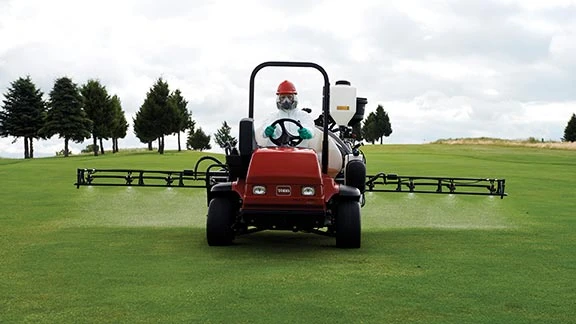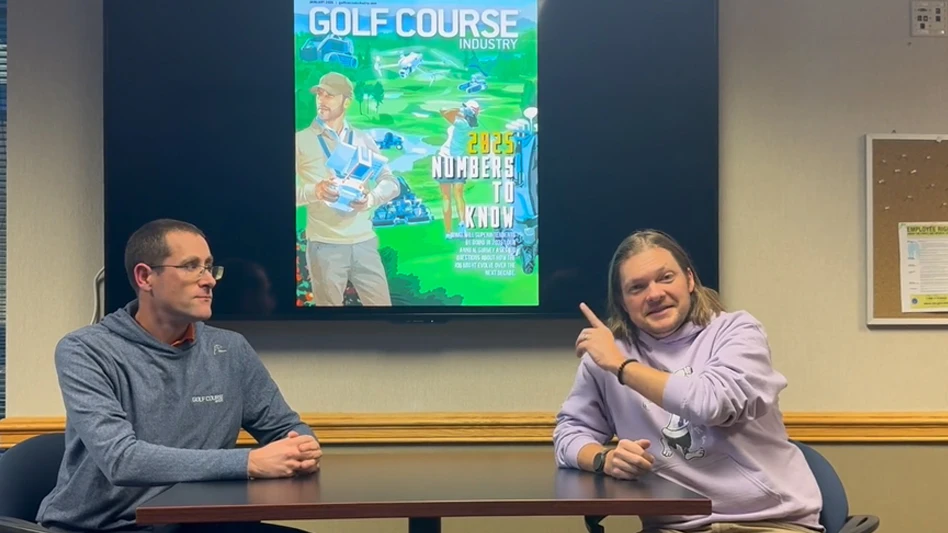
Creating a fungicide program for the spring is an individual endeavor. A superintendent must develop a protocol that suits their individual circumstances and there is a myriad of factors to be considered. One of them is cost.
Advance planning is necessary to develop a program that will be effective without adversely impacting the bottom line of the annual turf maintenance budget and perhaps leaving the superintendent without the necessary financial resources to combat an unexpected problem late in the season.
As luxurious as it may sound, Dr. Brandon Horvath, a turf pathologist at the University of Tennessee, suggests that when creating their spring program, superintendents should take a sky-is-the-limit approach.
“I always approach preparing a fungicide program from the perspective of money being no object,” Horvath says. “What would I do if I had no budget and I could do anything I wanted? Put together that plan and then work backwards toward your budget by substituting materials that are less expensive for more expensive ones, by maybe changing an active ingredient from something that’s brand new to something that’s been around for a while and may be a little less expensive, but always with the idea that you’re trying to maintain the best possible control that you can maintain. Then it’s a matter of not only being confident in that plan, but also being aware that you may need to make some adjustments.”
Superintendents are justifiably proud of their record as environmental stewards but concerns about environmental issues have increased in recent years. Today’s superintendent is expected to use less product to achieve the same results with regard to visual appeal and playability.
And while environmental concerns are much more important than in the past, Dr. Alex Ellram, a professor of animal and plant sciences at SUNY Cobleskill, says in most cases there are limits to the amount and frequency of a fungicide a superintendent can apply to an area.
“For example, chlorothalonil could be used continuously in the past, but now has restrictions on how much can applied each year,” Ellram says. “Also, a much greater knowledge base of BMPs [best management practices] to manage diseases with less fungicide is available today. This may allow superintendents to reduce their use of disease management chemicals.”
Resistance is another issue golf course superintendents contend with. “It’s important to know what to look for when resistance develops and how to minimize the potential for resistance to develop,” Ellram says, adding that some products are more prone to resistance issues than others.
“Pesticides that attack a pest in more than one way, like multi-site fungicides – such as chlorothalonil – have very low risk of developing resistance problems,” he says.a “On the other hand, fungicides that have one specific way to attack a pest – for example, propiconazole – have a fairly high potential of losing their ability to control fungal diseases through overuse.”
As every superintendent knows, it’s important to rotate products for maximum effectiveness. But Ellram points out that it’s important to alternate products that work in different ways.
“Simply changing chemicals does not mean you are rotating modes of action,” he says. “For example, the fungicide propiconazole and the fungicide triadimefon both have nearly the same mode of action.So, switching between these fungicides is not a proper rotation to delay resistance.”
There is more to a fungicide program than the product itself. Dr. Jim Kerns at North Carolina State University urges superintendents to “Do a little self-reflection,” when developing a fungicide program.
“Am I providing the things a plant needs to be healthy?” he says. “Is the plant receiving enough light, air, food and water? Changing cultural practices such as topdressing, fertility and watering practices can be very important for managing diseases. So, when developing a fungicide program, be sure to evaluate the cultural management as well. Remember the definition of insanity is doing the same thing over and over again while expecting different results.”
Kerns says product representatives can be a big help to superintendents who are putting together a fungicide program. “I think produce reps can be very effective,” he says, “especially those that sell everything. They typically are locals and are familiar with the environment and diseases that typically develop. Moreover, at least the ones I deal with consult extension faculty regularly. Reps for the major chemical manufacturers are also helpful as they have very broad experiences and have access to technical product managers. Most of the technical product managers were turfgrass scientists at one time and have excellent experience.”
Kerns notes that superintendents should not hesitate to question their product reps about a particular product. “Ask questions about why this product?” he says, or ‘What do you think of this? Keep in mind the diseases you the superintendent face and develop the program for those diseases. Don’t spray a product because your neighbor is or a big-name club saw this response.”
In the end, of course, the superintendent is responsible for what happens to his golf course and the chemicals he is applying to it. It behooves him to become as knowledgeable as possible about the effects of those products.
“I think that knowledge is power,” Ellram says. “It’s not rocket science to put together a good fungicide program. My students at SUNY Cobleskill are required to prepare fungicide programs as part of their coursework. Learn the basics and put together your own program as a starting point even if you will be working with a rep.”
Latest from Golf Course Industry
- Landscapes Golf Management adds two Illinois courses
- 2025 Super Social Media Awards: Joe Gulotti
- Grand Elk GC to be managed by Troon
- Envu earns EcoVadis Gold Rating for sustainability leadership
- Industry consulting firm unveils new name
- A robotic fleet near the Bay
- 2025 Super Social Media Awards: Brent Downs
- Reel Turf Techs: Ron McCall





